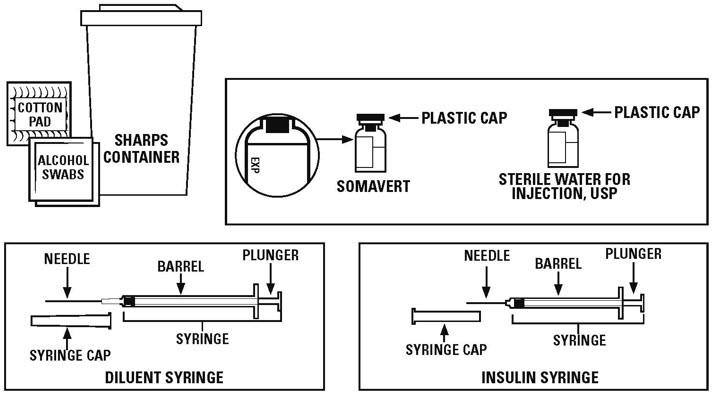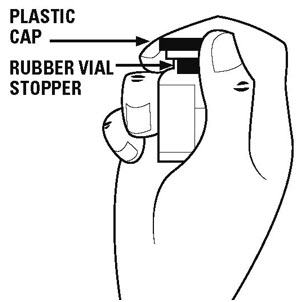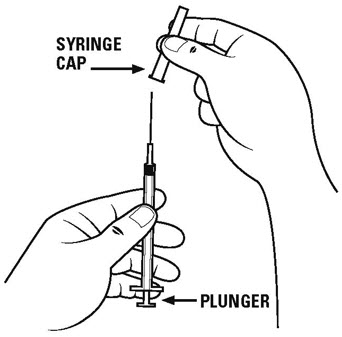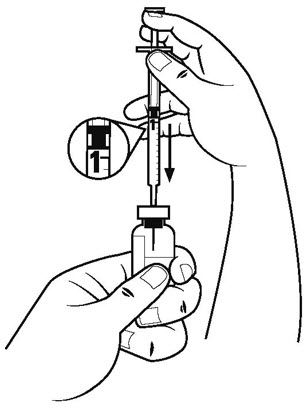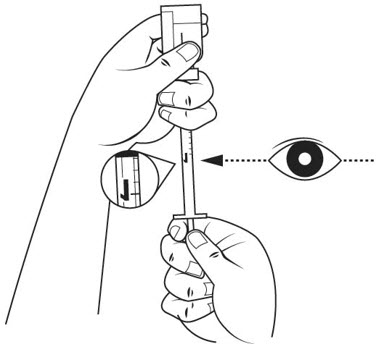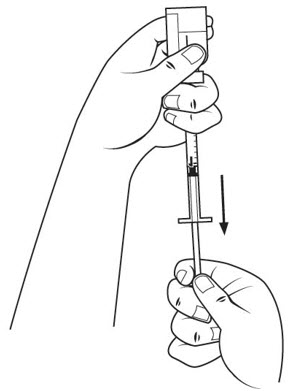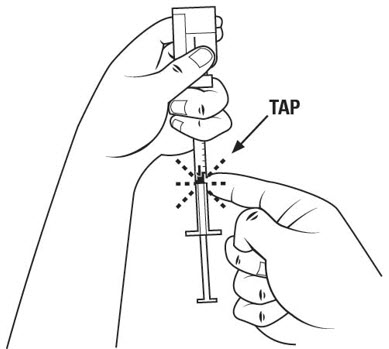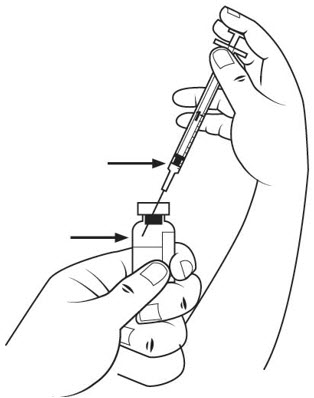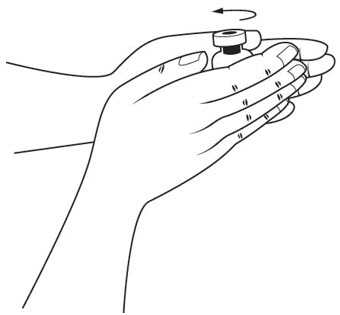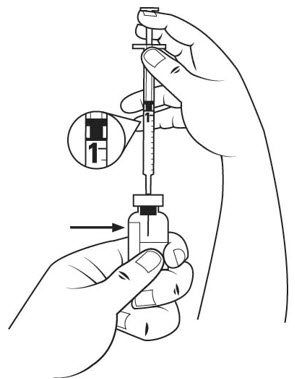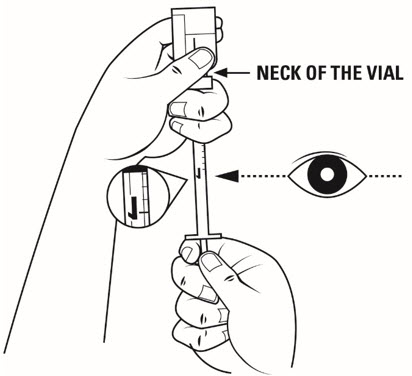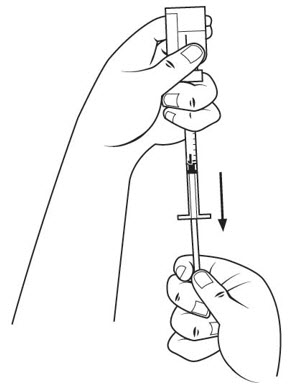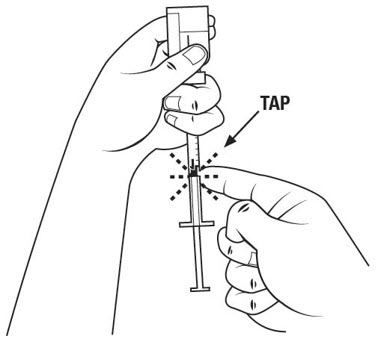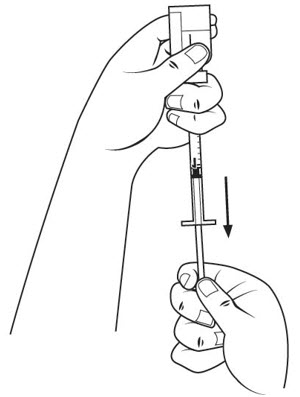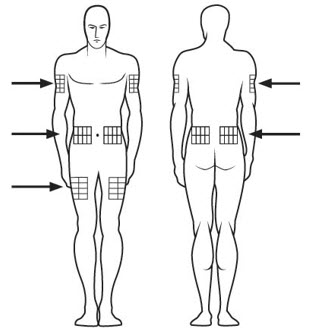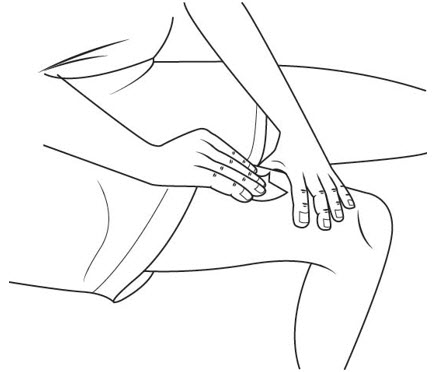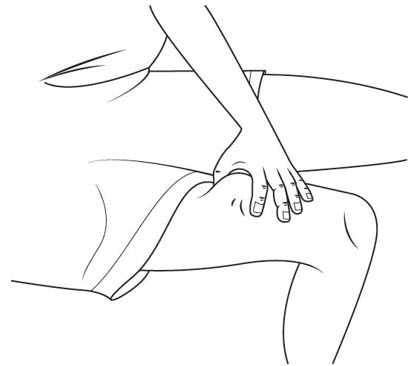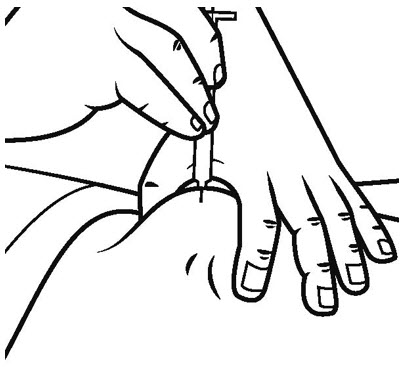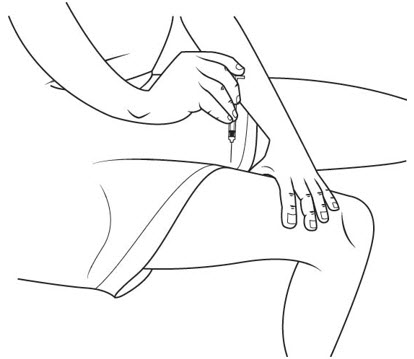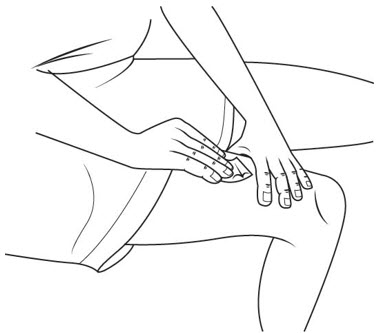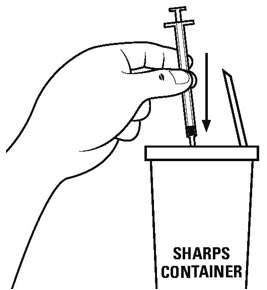SOMAVERT® WITH DILUENT VIAL Full Patient Information
(pegvisomant)
Full Patient Information
17 PATIENT COUNSELING INFORMATION
Advise the patient to read the FDA-approved patient labeling (Patient Information and Instructions for Use).
Inform patients (and/or their caregivers) of the following information to aid in the safe and effective use of SOMAVERT:
- •
- Not to use SOMAVERT if they are allergic to SOMAVERT or anything in it.
- •
- They will need blood testing to check IGF-1 levels and liver tests before and during treatment with SOMAVERT and that the dose of SOMAVERT may be changed based on the results of these tests.
- •
- SOMAVERT has not been studied in pregnant women and instruct them to notify their healthcare provider as soon as they are aware that they are pregnant.
- •
- It is not known whether SOMAVERT is excreted in human milk and instruct them to notify their healthcare provider if they plan to do so.
- •
- Pregnancy: Inform female patients that treatment with SOMAVERT may result in unintended pregnancy [see Females and Males of Reproductive Potential (8.3)].
Advise patients (and/or their caregivers) of the following adverse reactions:
- •
- The most common reported adverse reactions are injection site reaction, elevations of liver tests, pain, nausea, and diarrhea.
- •
- If they have liver test elevations they may need to have more frequent liver tests and/or discontinue SOMAVERT. Instruct patients to immediately discontinue therapy and contact their physician if they become jaundiced.
- •
- GH-secreting tumors may enlarge in people with acromegaly and that these tumors need to be watched carefully and monitored by MRI imaging.
- •
- Thickening under the skin may occur at the injection site that could lead to lumps and that switching sites may prevent or lessen this.
- •
- If they have diabetes mellitus, they may require careful monitoring and dose reductions of insulin and/or oral hypoglycemic agents while on SOMAVERT.
- •
- If they take opioids, they may need higher SOMAVERT doses to achieve appropriate IGF-1 suppression.
Advise patients that SOMAVERT is supplied as lyophilized powder in different strengths of 10 mg, 15 mg, 20 mg, 25 mg, and 30 mg in a sterile glass vial within a package also containing a single-dose flip top vial of sterile water (diluent) for injection. Advise patients that the stoppers on both vials are not made with natural rubber latex. Advise patients to follow the directions for reconstitution provided with each package including shaking may cause denaturation (destruction) of the active ingredient (therefore do not shake).
Advise patients that the package of SOMAVERT should be stored in a refrigerator 2°C to 8°C (36°F to 46°F) prior to use. It should NOT BE FROZEN.
INSTRUCTIONS FOR USE
SOMAVERT (SOM-ah-vert)
(pegvisomant)
for injection, for subcutaneous use
Read this Instructions for Use before you start using SOMAVERT and each time you get a refill. There may be new information. This leaflet does not take the place of talking to your healthcare provider about your medical condition or your treatment. Your healthcare provider should show you or a caregiver how to inject SOMAVERT the right way before you inject it for the first time.
Important Information:
- •
- SOMAVERT is for use under the skin only (subcutaneous).
- •
- Do not share your SOMAVERT syringes or needles with anyone else. You may give an infection to them or get an infection from them.
- •
- Do not use SOMAVERT after the expiration date (EXP) on the label.
- •
- Inject SOMAVERT within 6 hours of mixing it. If you wait more than 6 hours, you must throw away the medicine without injecting it.
Supplies you need to give each injection of SOMAVERT. See Figure A.
- •
- 1 package of SOMAVERT that contains:
- o
- 1 vial of powdered SOMAVERT medicine (powder vial)
- o
- 1 vial of liquid (diluent) labeled "Sterile Water for Injection, USP" to mix the powdered medicine
- The vials in the package of SOMAVERT have stoppers that are not made with natural rubber latex.
- The SOMAVERT package does not come with syringes and needles.
- •
- a 1 mL syringe with a 21 gauge to 27 gauge needle that is at least 1 inch long. This is the syringe and needle needed to mix the medicine (diluent syringe).
- •
- a 1 mL insulin syringe with attached needle. This is the syringe needed for your injection.
- •
- 2 alcohol swabs
- •
- 1 small clean, dry cotton pad
- •
- 1 sharps disposal container for throwing away used needles and syringes. See "Disposing of used needles and syringes" at the end of these instructions.
- •
- a clean, flat surface to work on, like a table
Preparing and mixing your SOMAVERT medicine
The SOMAVERT medicine comes as a dry powder. Before you use SOMAVERT, you must mix the dry powder with the vial of diluent that comes in the SOMAVERT package.
Do not use any other liquid to mix the medicine.
Note: If you need to give 2 injections for your SOMAVERT dose, you need 2 packages of SOMAVERT to prepare 2 separate vials of medicine.
Step 1. Remove 1 package of SOMAVERT from the refrigerator about 10 minutes before you plan to give your SOMAVERT injection. Let the SOMAVERT stand at room temperature to warm up the medicine.
Step 2. Wash your hands with soap and warm water. Dry your hands well.
Step 3. Remove the plastic caps from the tops of the powder vial and the diluent vial. See Figure B.
Do not touch the rubber vial stoppers. The stoppers are clean. If the stoppers are touched by anything, you must clean them with an alcohol swab before use.
Step 4. Carefully remove the cap from the diluent syringe with the larger needle and set the cap aside on the table. See Figure C.
Step 5. Pull the plunger of the diluent syringe out to the 1 mL mark. With 1 hand, firmly hold the vial of diluent. With the other hand, push the needle of the diluent syringe straight through the center of the rubber stopper and deep into the vial. Gently push the plunger in until the air is injected into the vial. See Figure D.
Step 6. Firmly hold the diluent vial and syringe together, with the needle still in the vial. Then turn the diluent vial with the diluent syringe upside down. Hold them at eye level. See Figure E.
Step 7. Slide 1 hand carefully down the diluent vial so you can firmly hold the neck of the vial with your thumb and forefinger. Hold the upper part of the syringe with your other fingers. With the other hand, slowly pull the plunger out to the 1 mL mark on the diluent syringe. See Figure F.
Step 8. Check the diluent syringe for air bubbles. If you see bubbles, tap the diluent syringe barrel until the bubbles rise to the top of the syringe. Carefully push the plunger in to push only the air bubbles back into the vial. See Figure G. If you push too much of the liquid back into the vial, pull the plunger out again to the 1 mL mark.
Step 9. Make sure that 1 mL of diluent remains in the diluent syringe. Pull the needle out of the vial. The vial should still have diluent in it. Do not use the leftover diluent in the vial.
Step 10. Push the needle of the diluent syringe straight through the stopper of the vial of powdered SOMAVERT.
Then, tilt the diluent syringe to the side and gently push the plunger to inject the diluent down the inner side of the SOMAVERT powder vial. Be sure the diluent does not fall directly on the powder, but flows down the inside wall of the vial. See Figure H.
Step 11. When the diluent syringe is empty, pull the needle out of the powder vial.
Throw away the diluent vial with the leftover liquid in it. Throw away the diluent syringe and needle in the sharps container. See "Disposing of used needles and syringes" at the end of these instructions.
Step 12. Hold the medicine vial of SOMAVERT upright between your hands and gently roll it to dissolve the powder into a solution. See Figure I.
- •
- Do not shake the medicine vial. Shaking may destroy the medicine.
- •
- The liquid medicine should be clear after the powder is dissolved. Do not use the vial if:
- o
- the liquid medicine looks cloudy, hazy, or slightly colored or
- o
- you see solid particles in the liquid medicine or
- o
- you see foam in the vial
- Tell your pharmacist and ask for another vial. Do not throw the vial away because the pharmacist may ask that you return it.
- •
- Inject SOMAVERT within 6 hours of mixing it. If you wait more than 6 hours, you must throw away the medicine without injecting it.
- •
- Each mixed medicine vial contains 1 dose of SOMAVERT. Do not split the liquid medicine into multiple doses.
Preparing your SOMAVERT injection syringe:
Step 13. Clean the rubber stopper of the vial of SOMAVERT with an alcohol swab.
- •
- Carefully remove the cap from the insulin syringe and set the cap on the table.
- •
- Pull the insulin syringe plunger out to the 1 mL mark. With 1 hand, firmly hold the vial. With the other hand, push the needle straight through the center of the rubber stopper and deep into the vial. Gently push the plunger in until the air is injected into the medicine vial. See Figure J.
Step 14. Firmly hold the medicine solution vial and insulin syringe together, with the needle still deeply inserted into the vial. Carefully turn the vial and syringe together upside down. Hold them at eye level. See Figure K.
Step 15. Slide 1 hand carefully down the medicine solution vial so you can firmly hold the neck of the vial with your thumb and forefinger. Hold the upper part of the syringe with your other fingers. With the other hand, slowly pull the plunger out to the 1 mL mark on the insulin syringe. See Figure L.
Step 16. Check the insulin syringe for air bubbles. If you see bubbles, tap the insulin syringe barrel until the bubbles rise to the top of the syringe. Carefully push the plunger in to push only the air bubbles back into the vial. See Figure M.
Step 17. Withdraw the entire 1 mL of medicine solution from the vial. If your dose of SOMAVERT is less than 1 mL, your healthcare provider will tell you how much medicine solution to withdraw. Slowly withdraw the needle to keep the tip in the liquid until you get all the medicine solution you need out of the vial. See Figure N.
Note:
- •
- If your dose of SOMAVERT is less than 1 mL, your healthcare provider will tell you how much medicine solution to withdraw.
- •
- If your dose of SOMAVERT is more than 1 mL, your healthcare provider will tell you how much more medicine solution to withdraw from a second vial into another syringe, and where to give your second injection.
Set the syringe and needle on the table without anything touching the needle.
Selecting your SOMAVERT injection site:
Step 18. SOMAVERT is injected under the skin (subcutaneous). Injection sites may include your upper arm, upper thigh, stomach area (abdomen) and buttocks. See Figure O.
- •
- Choose your injection site from 1 of the areas your healthcare provider told you to use. Only a caregiver can inject in your upper arm.
- •
- Choose a different injection site each day so lumps do not develop in your skin. Keep a record of each day's injection site as you inject your daily dose of SOMAVERT.
- •
- Do not use an area of your body that has:
- o
- a rash
- o
- broken skin
- o
- bruising
- o
- lumps in your skin
- •
- If you need to give 2 injections for your dose of SOMAVERT, choose a different site for your second injection.
Giving your SOMAVERT injection:
Step 19. Clean your injection site with an alcohol swab. See Figure P.
Let your skin dry before you inject your medicine.
Step 20. With 1 hand, gently pinch up your skin at your injection site. See Figure Q.
Step 21. Carefully pick up the insulin syringe with your other hand and hold it like a pen. In a single, smooth motion, push the needle straight down and completely into your skin (at a 90-degree angle).
- •
- Keep the needle pushed all the way into your skin while you slowly push the syringe plunger in with the index finger of your other hand. See Figure R.
- •
- Keep the needle all the way into your skin until all of the medicine is injected under your skin and the insulin syringe is empty.
Step 22. Release your pinched skin and pull the needle straight out. See Figure S.
Step 23. Do not rub your injection area. A small amount of bleeding may happen.
If you have a small amount of bleeding, press a small clean, dry cotton pad over the area and press gently for 1 or 2 minutes, or until the bleeding has stopped. See Figure T.
Disposing of used needles and syringes:
- •
- Put your used needles and syringes in a FDA-cleared sharps disposal container right away after use. See Figure U. Do not throw away (dispose of) loose needles and syringes in your household trash.
- •
- If you do not have a FDA-cleared sharps disposal container, you may use a household container that is:
- o
- made of a heavy-duty plastic,
- o
- can be closed with a tight-fitting, puncture-resistant lid, without sharps being able to come out,
- o
- upright and stable during use,
- o
- leak-resistant, and
- o
- properly labeled to warn of hazardous waste inside the container.
- •
- When your sharps disposal container is almost full, you will need to follow your community guidelines for the right way to dispose of your sharps disposal container. There may be state or local laws about how you should throw away used needles and syringes. For more information about safe sharps disposal, and for specific information about sharps disposal in the state that you live in, go to the FDA's website at: http://www.fda.gov/safesharpdisposal.
- •
- Do not dispose of your used sharps disposal container in your household trash unless your community guidelines permit this. Do not recycle your used sharps disposal container.
This Instructions for Use has been approved by the U.S. Food and Drug Administration.
U.S. License No. 1216
LAB-1362-3.0
Revised: July 2023
Find SOMAVERT® WITH DILUENT VIAL medical information:
Find SOMAVERT® WITH DILUENT VIAL medical information:
SOMAVERT® WITH DILUENT VIAL Quick Finder
Health Professional Information
Full Patient Information
Full Patient Information
17 PATIENT COUNSELING INFORMATION
Advise the patient to read the FDA-approved patient labeling (Patient Information and Instructions for Use).
Inform patients (and/or their caregivers) of the following information to aid in the safe and effective use of SOMAVERT:
- •
- Not to use SOMAVERT if they are allergic to SOMAVERT or anything in it.
- •
- They will need blood testing to check IGF-1 levels and liver tests before and during treatment with SOMAVERT and that the dose of SOMAVERT may be changed based on the results of these tests.
- •
- SOMAVERT has not been studied in pregnant women and instruct them to notify their healthcare provider as soon as they are aware that they are pregnant.
- •
- It is not known whether SOMAVERT is excreted in human milk and instruct them to notify their healthcare provider if they plan to do so.
- •
- Pregnancy: Inform female patients that treatment with SOMAVERT may result in unintended pregnancy [see Females and Males of Reproductive Potential (8.3)].
Advise patients (and/or their caregivers) of the following adverse reactions:
- •
- The most common reported adverse reactions are injection site reaction, elevations of liver tests, pain, nausea, and diarrhea.
- •
- If they have liver test elevations they may need to have more frequent liver tests and/or discontinue SOMAVERT. Instruct patients to immediately discontinue therapy and contact their physician if they become jaundiced.
- •
- GH-secreting tumors may enlarge in people with acromegaly and that these tumors need to be watched carefully and monitored by MRI imaging.
- •
- Thickening under the skin may occur at the injection site that could lead to lumps and that switching sites may prevent or lessen this.
- •
- If they have diabetes mellitus, they may require careful monitoring and dose reductions of insulin and/or oral hypoglycemic agents while on SOMAVERT.
- •
- If they take opioids, they may need higher SOMAVERT doses to achieve appropriate IGF-1 suppression.
Advise patients that SOMAVERT is supplied as lyophilized powder in different strengths of 10 mg, 15 mg, 20 mg, 25 mg, and 30 mg in a sterile glass vial within a package also containing a single-dose flip top vial of sterile water (diluent) for injection. Advise patients that the stoppers on both vials are not made with natural rubber latex. Advise patients to follow the directions for reconstitution provided with each package including shaking may cause denaturation (destruction) of the active ingredient (therefore do not shake).
Advise patients that the package of SOMAVERT should be stored in a refrigerator 2°C to 8°C (36°F to 46°F) prior to use. It should NOT BE FROZEN.
INSTRUCTIONS FOR USE
SOMAVERT (SOM-ah-vert)
(pegvisomant)
for injection, for subcutaneous use
Read this Instructions for Use before you start using SOMAVERT and each time you get a refill. There may be new information. This leaflet does not take the place of talking to your healthcare provider about your medical condition or your treatment. Your healthcare provider should show you or a caregiver how to inject SOMAVERT the right way before you inject it for the first time.
Important Information:
- •
- SOMAVERT is for use under the skin only (subcutaneous).
- •
- Do not share your SOMAVERT syringes or needles with anyone else. You may give an infection to them or get an infection from them.
- •
- Do not use SOMAVERT after the expiration date (EXP) on the label.
- •
- Inject SOMAVERT within 6 hours of mixing it. If you wait more than 6 hours, you must throw away the medicine without injecting it.
Supplies you need to give each injection of SOMAVERT. See Figure A.
- •
- 1 package of SOMAVERT that contains:
- o
- 1 vial of powdered SOMAVERT medicine (powder vial)
- o
- 1 vial of liquid (diluent) labeled "Sterile Water for Injection, USP" to mix the powdered medicine
- The vials in the package of SOMAVERT have stoppers that are not made with natural rubber latex.
- The SOMAVERT package does not come with syringes and needles.
- •
- a 1 mL syringe with a 21 gauge to 27 gauge needle that is at least 1 inch long. This is the syringe and needle needed to mix the medicine (diluent syringe).
- •
- a 1 mL insulin syringe with attached needle. This is the syringe needed for your injection.
- •
- 2 alcohol swabs
- •
- 1 small clean, dry cotton pad
- •
- 1 sharps disposal container for throwing away used needles and syringes. See "Disposing of used needles and syringes" at the end of these instructions.
- •
- a clean, flat surface to work on, like a table
Preparing and mixing your SOMAVERT medicine
The SOMAVERT medicine comes as a dry powder. Before you use SOMAVERT, you must mix the dry powder with the vial of diluent that comes in the SOMAVERT package.
Do not use any other liquid to mix the medicine.
Note: If you need to give 2 injections for your SOMAVERT dose, you need 2 packages of SOMAVERT to prepare 2 separate vials of medicine.
Step 1. Remove 1 package of SOMAVERT from the refrigerator about 10 minutes before you plan to give your SOMAVERT injection. Let the SOMAVERT stand at room temperature to warm up the medicine.
Step 2. Wash your hands with soap and warm water. Dry your hands well.
Step 3. Remove the plastic caps from the tops of the powder vial and the diluent vial. See Figure B.
Do not touch the rubber vial stoppers. The stoppers are clean. If the stoppers are touched by anything, you must clean them with an alcohol swab before use.
Step 4. Carefully remove the cap from the diluent syringe with the larger needle and set the cap aside on the table. See Figure C.
Step 5. Pull the plunger of the diluent syringe out to the 1 mL mark. With 1 hand, firmly hold the vial of diluent. With the other hand, push the needle of the diluent syringe straight through the center of the rubber stopper and deep into the vial. Gently push the plunger in until the air is injected into the vial. See Figure D.
Step 6. Firmly hold the diluent vial and syringe together, with the needle still in the vial. Then turn the diluent vial with the diluent syringe upside down. Hold them at eye level. See Figure E.
Step 7. Slide 1 hand carefully down the diluent vial so you can firmly hold the neck of the vial with your thumb and forefinger. Hold the upper part of the syringe with your other fingers. With the other hand, slowly pull the plunger out to the 1 mL mark on the diluent syringe. See Figure F.
Step 8. Check the diluent syringe for air bubbles. If you see bubbles, tap the diluent syringe barrel until the bubbles rise to the top of the syringe. Carefully push the plunger in to push only the air bubbles back into the vial. See Figure G. If you push too much of the liquid back into the vial, pull the plunger out again to the 1 mL mark.
Step 9. Make sure that 1 mL of diluent remains in the diluent syringe. Pull the needle out of the vial. The vial should still have diluent in it. Do not use the leftover diluent in the vial.
Step 10. Push the needle of the diluent syringe straight through the stopper of the vial of powdered SOMAVERT.
Then, tilt the diluent syringe to the side and gently push the plunger to inject the diluent down the inner side of the SOMAVERT powder vial. Be sure the diluent does not fall directly on the powder, but flows down the inside wall of the vial. See Figure H.
Step 11. When the diluent syringe is empty, pull the needle out of the powder vial.
Throw away the diluent vial with the leftover liquid in it. Throw away the diluent syringe and needle in the sharps container. See "Disposing of used needles and syringes" at the end of these instructions.
Step 12. Hold the medicine vial of SOMAVERT upright between your hands and gently roll it to dissolve the powder into a solution. See Figure I.
- •
- Do not shake the medicine vial. Shaking may destroy the medicine.
- •
- The liquid medicine should be clear after the powder is dissolved. Do not use the vial if:
- o
- the liquid medicine looks cloudy, hazy, or slightly colored or
- o
- you see solid particles in the liquid medicine or
- o
- you see foam in the vial
- Tell your pharmacist and ask for another vial. Do not throw the vial away because the pharmacist may ask that you return it.
- •
- Inject SOMAVERT within 6 hours of mixing it. If you wait more than 6 hours, you must throw away the medicine without injecting it.
- •
- Each mixed medicine vial contains 1 dose of SOMAVERT. Do not split the liquid medicine into multiple doses.
Preparing your SOMAVERT injection syringe:
Step 13. Clean the rubber stopper of the vial of SOMAVERT with an alcohol swab.
- •
- Carefully remove the cap from the insulin syringe and set the cap on the table.
- •
- Pull the insulin syringe plunger out to the 1 mL mark. With 1 hand, firmly hold the vial. With the other hand, push the needle straight through the center of the rubber stopper and deep into the vial. Gently push the plunger in until the air is injected into the medicine vial. See Figure J.
Step 14. Firmly hold the medicine solution vial and insulin syringe together, with the needle still deeply inserted into the vial. Carefully turn the vial and syringe together upside down. Hold them at eye level. See Figure K.
Step 15. Slide 1 hand carefully down the medicine solution vial so you can firmly hold the neck of the vial with your thumb and forefinger. Hold the upper part of the syringe with your other fingers. With the other hand, slowly pull the plunger out to the 1 mL mark on the insulin syringe. See Figure L.
Step 16. Check the insulin syringe for air bubbles. If you see bubbles, tap the insulin syringe barrel until the bubbles rise to the top of the syringe. Carefully push the plunger in to push only the air bubbles back into the vial. See Figure M.
Step 17. Withdraw the entire 1 mL of medicine solution from the vial. If your dose of SOMAVERT is less than 1 mL, your healthcare provider will tell you how much medicine solution to withdraw. Slowly withdraw the needle to keep the tip in the liquid until you get all the medicine solution you need out of the vial. See Figure N.
Note:
- •
- If your dose of SOMAVERT is less than 1 mL, your healthcare provider will tell you how much medicine solution to withdraw.
- •
- If your dose of SOMAVERT is more than 1 mL, your healthcare provider will tell you how much more medicine solution to withdraw from a second vial into another syringe, and where to give your second injection.
Set the syringe and needle on the table without anything touching the needle.
Selecting your SOMAVERT injection site:
Step 18. SOMAVERT is injected under the skin (subcutaneous). Injection sites may include your upper arm, upper thigh, stomach area (abdomen) and buttocks. See Figure O.
- •
- Choose your injection site from 1 of the areas your healthcare provider told you to use. Only a caregiver can inject in your upper arm.
- •
- Choose a different injection site each day so lumps do not develop in your skin. Keep a record of each day's injection site as you inject your daily dose of SOMAVERT.
- •
- Do not use an area of your body that has:
- o
- a rash
- o
- broken skin
- o
- bruising
- o
- lumps in your skin
- •
- If you need to give 2 injections for your dose of SOMAVERT, choose a different site for your second injection.
Giving your SOMAVERT injection:
Step 19. Clean your injection site with an alcohol swab. See Figure P.
Let your skin dry before you inject your medicine.
Step 20. With 1 hand, gently pinch up your skin at your injection site. See Figure Q.
Step 21. Carefully pick up the insulin syringe with your other hand and hold it like a pen. In a single, smooth motion, push the needle straight down and completely into your skin (at a 90-degree angle).
- •
- Keep the needle pushed all the way into your skin while you slowly push the syringe plunger in with the index finger of your other hand. See Figure R.
- •
- Keep the needle all the way into your skin until all of the medicine is injected under your skin and the insulin syringe is empty.
Step 22. Release your pinched skin and pull the needle straight out. See Figure S.
Step 23. Do not rub your injection area. A small amount of bleeding may happen.
If you have a small amount of bleeding, press a small clean, dry cotton pad over the area and press gently for 1 or 2 minutes, or until the bleeding has stopped. See Figure T.
Disposing of used needles and syringes:
- •
- Put your used needles and syringes in a FDA-cleared sharps disposal container right away after use. See Figure U. Do not throw away (dispose of) loose needles and syringes in your household trash.
- •
- If you do not have a FDA-cleared sharps disposal container, you may use a household container that is:
- o
- made of a heavy-duty plastic,
- o
- can be closed with a tight-fitting, puncture-resistant lid, without sharps being able to come out,
- o
- upright and stable during use,
- o
- leak-resistant, and
- o
- properly labeled to warn of hazardous waste inside the container.
- •
- When your sharps disposal container is almost full, you will need to follow your community guidelines for the right way to dispose of your sharps disposal container. There may be state or local laws about how you should throw away used needles and syringes. For more information about safe sharps disposal, and for specific information about sharps disposal in the state that you live in, go to the FDA's website at: http://www.fda.gov/safesharpdisposal.
- •
- Do not dispose of your used sharps disposal container in your household trash unless your community guidelines permit this. Do not recycle your used sharps disposal container.
This Instructions for Use has been approved by the U.S. Food and Drug Administration.
U.S. License No. 1216
LAB-1362-3.0
Revised: July 2023
Health Professional Information
Full Patient Information
Full Patient Information
17 PATIENT COUNSELING INFORMATION
Advise the patient to read the FDA-approved patient labeling (Patient Information and Instructions for Use).
Inform patients (and/or their caregivers) of the following information to aid in the safe and effective use of SOMAVERT:
- •
- Not to use SOMAVERT if they are allergic to SOMAVERT or anything in it.
- •
- They will need blood testing to check IGF-1 levels and liver tests before and during treatment with SOMAVERT and that the dose of SOMAVERT may be changed based on the results of these tests.
- •
- SOMAVERT has not been studied in pregnant women and instruct them to notify their healthcare provider as soon as they are aware that they are pregnant.
- •
- It is not known whether SOMAVERT is excreted in human milk and instruct them to notify their healthcare provider if they plan to do so.
- •
- Pregnancy: Inform female patients that treatment with SOMAVERT may result in unintended pregnancy [see Females and Males of Reproductive Potential (8.3)].
Advise patients (and/or their caregivers) of the following adverse reactions:
- •
- The most common reported adverse reactions are injection site reaction, elevations of liver tests, pain, nausea, and diarrhea.
- •
- If they have liver test elevations they may need to have more frequent liver tests and/or discontinue SOMAVERT. Instruct patients to immediately discontinue therapy and contact their physician if they become jaundiced.
- •
- GH-secreting tumors may enlarge in people with acromegaly and that these tumors need to be watched carefully and monitored by MRI imaging.
- •
- Thickening under the skin may occur at the injection site that could lead to lumps and that switching sites may prevent or lessen this.
- •
- If they have diabetes mellitus, they may require careful monitoring and dose reductions of insulin and/or oral hypoglycemic agents while on SOMAVERT.
- •
- If they take opioids, they may need higher SOMAVERT doses to achieve appropriate IGF-1 suppression.
Advise patients that SOMAVERT is supplied as lyophilized powder in different strengths of 10 mg, 15 mg, 20 mg, 25 mg, and 30 mg in a sterile glass vial within a package also containing a single-dose flip top vial of sterile water (diluent) for injection. Advise patients that the stoppers on both vials are not made with natural rubber latex. Advise patients to follow the directions for reconstitution provided with each package including shaking may cause denaturation (destruction) of the active ingredient (therefore do not shake).
Advise patients that the package of SOMAVERT should be stored in a refrigerator 2°C to 8°C (36°F to 46°F) prior to use. It should NOT BE FROZEN.
INSTRUCTIONS FOR USE
SOMAVERT (SOM-ah-vert)
(pegvisomant)
for injection, for subcutaneous use
Read this Instructions for Use before you start using SOMAVERT and each time you get a refill. There may be new information. This leaflet does not take the place of talking to your healthcare provider about your medical condition or your treatment. Your healthcare provider should show you or a caregiver how to inject SOMAVERT the right way before you inject it for the first time.
Important Information:
- •
- SOMAVERT is for use under the skin only (subcutaneous).
- •
- Do not share your SOMAVERT syringes or needles with anyone else. You may give an infection to them or get an infection from them.
- •
- Do not use SOMAVERT after the expiration date (EXP) on the label.
- •
- Inject SOMAVERT within 6 hours of mixing it. If you wait more than 6 hours, you must throw away the medicine without injecting it.
Supplies you need to give each injection of SOMAVERT. See Figure A.
- •
- 1 package of SOMAVERT that contains:
- o
- 1 vial of powdered SOMAVERT medicine (powder vial)
- o
- 1 vial of liquid (diluent) labeled "Sterile Water for Injection, USP" to mix the powdered medicine
- The vials in the package of SOMAVERT have stoppers that are not made with natural rubber latex.
- The SOMAVERT package does not come with syringes and needles.
- •
- a 1 mL syringe with a 21 gauge to 27 gauge needle that is at least 1 inch long. This is the syringe and needle needed to mix the medicine (diluent syringe).
- •
- a 1 mL insulin syringe with attached needle. This is the syringe needed for your injection.
- •
- 2 alcohol swabs
- •
- 1 small clean, dry cotton pad
- •
- 1 sharps disposal container for throwing away used needles and syringes. See "Disposing of used needles and syringes" at the end of these instructions.
- •
- a clean, flat surface to work on, like a table
Preparing and mixing your SOMAVERT medicine
The SOMAVERT medicine comes as a dry powder. Before you use SOMAVERT, you must mix the dry powder with the vial of diluent that comes in the SOMAVERT package.
Do not use any other liquid to mix the medicine.
Note: If you need to give 2 injections for your SOMAVERT dose, you need 2 packages of SOMAVERT to prepare 2 separate vials of medicine.
Step 1. Remove 1 package of SOMAVERT from the refrigerator about 10 minutes before you plan to give your SOMAVERT injection. Let the SOMAVERT stand at room temperature to warm up the medicine.
Step 2. Wash your hands with soap and warm water. Dry your hands well.
Step 3. Remove the plastic caps from the tops of the powder vial and the diluent vial. See Figure B.
Do not touch the rubber vial stoppers. The stoppers are clean. If the stoppers are touched by anything, you must clean them with an alcohol swab before use.
Step 4. Carefully remove the cap from the diluent syringe with the larger needle and set the cap aside on the table. See Figure C.
Step 5. Pull the plunger of the diluent syringe out to the 1 mL mark. With 1 hand, firmly hold the vial of diluent. With the other hand, push the needle of the diluent syringe straight through the center of the rubber stopper and deep into the vial. Gently push the plunger in until the air is injected into the vial. See Figure D.
Step 6. Firmly hold the diluent vial and syringe together, with the needle still in the vial. Then turn the diluent vial with the diluent syringe upside down. Hold them at eye level. See Figure E.
Step 7. Slide 1 hand carefully down the diluent vial so you can firmly hold the neck of the vial with your thumb and forefinger. Hold the upper part of the syringe with your other fingers. With the other hand, slowly pull the plunger out to the 1 mL mark on the diluent syringe. See Figure F.
Step 8. Check the diluent syringe for air bubbles. If you see bubbles, tap the diluent syringe barrel until the bubbles rise to the top of the syringe. Carefully push the plunger in to push only the air bubbles back into the vial. See Figure G. If you push too much of the liquid back into the vial, pull the plunger out again to the 1 mL mark.
Step 9. Make sure that 1 mL of diluent remains in the diluent syringe. Pull the needle out of the vial. The vial should still have diluent in it. Do not use the leftover diluent in the vial.
Step 10. Push the needle of the diluent syringe straight through the stopper of the vial of powdered SOMAVERT.
Then, tilt the diluent syringe to the side and gently push the plunger to inject the diluent down the inner side of the SOMAVERT powder vial. Be sure the diluent does not fall directly on the powder, but flows down the inside wall of the vial. See Figure H.
Step 11. When the diluent syringe is empty, pull the needle out of the powder vial.
Throw away the diluent vial with the leftover liquid in it. Throw away the diluent syringe and needle in the sharps container. See "Disposing of used needles and syringes" at the end of these instructions.
Step 12. Hold the medicine vial of SOMAVERT upright between your hands and gently roll it to dissolve the powder into a solution. See Figure I.
- •
- Do not shake the medicine vial. Shaking may destroy the medicine.
- •
- The liquid medicine should be clear after the powder is dissolved. Do not use the vial if:
- o
- the liquid medicine looks cloudy, hazy, or slightly colored or
- o
- you see solid particles in the liquid medicine or
- o
- you see foam in the vial
- Tell your pharmacist and ask for another vial. Do not throw the vial away because the pharmacist may ask that you return it.
- •
- Inject SOMAVERT within 6 hours of mixing it. If you wait more than 6 hours, you must throw away the medicine without injecting it.
- •
- Each mixed medicine vial contains 1 dose of SOMAVERT. Do not split the liquid medicine into multiple doses.
Preparing your SOMAVERT injection syringe:
Step 13. Clean the rubber stopper of the vial of SOMAVERT with an alcohol swab.
- •
- Carefully remove the cap from the insulin syringe and set the cap on the table.
- •
- Pull the insulin syringe plunger out to the 1 mL mark. With 1 hand, firmly hold the vial. With the other hand, push the needle straight through the center of the rubber stopper and deep into the vial. Gently push the plunger in until the air is injected into the medicine vial. See Figure J.
Step 14. Firmly hold the medicine solution vial and insulin syringe together, with the needle still deeply inserted into the vial. Carefully turn the vial and syringe together upside down. Hold them at eye level. See Figure K.
Step 15. Slide 1 hand carefully down the medicine solution vial so you can firmly hold the neck of the vial with your thumb and forefinger. Hold the upper part of the syringe with your other fingers. With the other hand, slowly pull the plunger out to the 1 mL mark on the insulin syringe. See Figure L.
Step 16. Check the insulin syringe for air bubbles. If you see bubbles, tap the insulin syringe barrel until the bubbles rise to the top of the syringe. Carefully push the plunger in to push only the air bubbles back into the vial. See Figure M.
Step 17. Withdraw the entire 1 mL of medicine solution from the vial. If your dose of SOMAVERT is less than 1 mL, your healthcare provider will tell you how much medicine solution to withdraw. Slowly withdraw the needle to keep the tip in the liquid until you get all the medicine solution you need out of the vial. See Figure N.
Note:
- •
- If your dose of SOMAVERT is less than 1 mL, your healthcare provider will tell you how much medicine solution to withdraw.
- •
- If your dose of SOMAVERT is more than 1 mL, your healthcare provider will tell you how much more medicine solution to withdraw from a second vial into another syringe, and where to give your second injection.
Set the syringe and needle on the table without anything touching the needle.
Selecting your SOMAVERT injection site:
Step 18. SOMAVERT is injected under the skin (subcutaneous). Injection sites may include your upper arm, upper thigh, stomach area (abdomen) and buttocks. See Figure O.
- •
- Choose your injection site from 1 of the areas your healthcare provider told you to use. Only a caregiver can inject in your upper arm.
- •
- Choose a different injection site each day so lumps do not develop in your skin. Keep a record of each day's injection site as you inject your daily dose of SOMAVERT.
- •
- Do not use an area of your body that has:
- o
- a rash
- o
- broken skin
- o
- bruising
- o
- lumps in your skin
- •
- If you need to give 2 injections for your dose of SOMAVERT, choose a different site for your second injection.
Giving your SOMAVERT injection:
Step 19. Clean your injection site with an alcohol swab. See Figure P.
Let your skin dry before you inject your medicine.
Step 20. With 1 hand, gently pinch up your skin at your injection site. See Figure Q.
Step 21. Carefully pick up the insulin syringe with your other hand and hold it like a pen. In a single, smooth motion, push the needle straight down and completely into your skin (at a 90-degree angle).
- •
- Keep the needle pushed all the way into your skin while you slowly push the syringe plunger in with the index finger of your other hand. See Figure R.
- •
- Keep the needle all the way into your skin until all of the medicine is injected under your skin and the insulin syringe is empty.
Step 22. Release your pinched skin and pull the needle straight out. See Figure S.
Step 23. Do not rub your injection area. A small amount of bleeding may happen.
If you have a small amount of bleeding, press a small clean, dry cotton pad over the area and press gently for 1 or 2 minutes, or until the bleeding has stopped. See Figure T.
Disposing of used needles and syringes:
- •
- Put your used needles and syringes in a FDA-cleared sharps disposal container right away after use. See Figure U. Do not throw away (dispose of) loose needles and syringes in your household trash.
- •
- If you do not have a FDA-cleared sharps disposal container, you may use a household container that is:
- o
- made of a heavy-duty plastic,
- o
- can be closed with a tight-fitting, puncture-resistant lid, without sharps being able to come out,
- o
- upright and stable during use,
- o
- leak-resistant, and
- o
- properly labeled to warn of hazardous waste inside the container.
- •
- When your sharps disposal container is almost full, you will need to follow your community guidelines for the right way to dispose of your sharps disposal container. There may be state or local laws about how you should throw away used needles and syringes. For more information about safe sharps disposal, and for specific information about sharps disposal in the state that you live in, go to the FDA's website at: http://www.fda.gov/safesharpdisposal.
- •
- Do not dispose of your used sharps disposal container in your household trash unless your community guidelines permit this. Do not recycle your used sharps disposal container.
This Instructions for Use has been approved by the U.S. Food and Drug Administration.
U.S. License No. 1216
LAB-1362-3.0
Revised: July 2023
Resources
Didn’t find what you were looking for? Contact us.
Chat online with Pfizer Medical Information regarding your inquiry on a Pfizer medicine.
*Contact Medical Information.9AM-5PM ET Monday to Friday; excluding holidays.
Report Adverse Event
Pfizer Safety
To report an adverse event related to the Pfizer-BioNTech COVID-19 Vaccine, and you are not part of a clinical trial* for this product, click the link below to submit your information:
Pfizer Safety Reporting Site*If you are involved in a clinical trial for this product, adverse events should be reported to your coordinating study site.
If you cannot use the above website, or would like to report an adverse event related to a different Pfizer product, please call Pfizer Safety at (800) 438-1985.
FDA Medwatch
You may also contact the U.S. Food and Drug Administration (FDA) directly to report adverse events or product quality concerns either online at www.fda.gov/medwatch or call (800) 822-7967.

